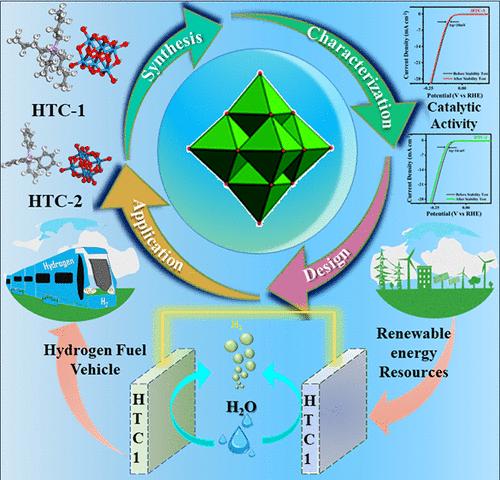Tetraalkyl/Alkyltriphenylphosphonium Hexatungstates for Efficient Electrocatalytic Hydrogen Evolution Reaction in Alkaline Media: An Experimental and In Silico-Based Synchronization Approach
IF 8.3
2区 材料科学
Q1 MATERIALS SCIENCE, MULTIDISCIPLINARY
引用次数: 0
Abstract
The development of stable, cost-effective, noble metal-free, and highly efficient electrocatalysts embraces great potential for efficient hydrogen production through water electrolysis. Herein, tetraalkyl/alkyltriphenylphosphonium hexatungstate-based Lindqvist polyoxometalates named HTC-1 and HTC-2, respectively, have been synthesized and characterized as promising electrocatalysts for effectual water-splitting reactions. The inclusion of tetrabutyl- and allyltriphenylphosphonium bromides as precursors into hexatungstate ions (W6O192–) exhibited a synergistic effect that promoted a notable improvement in the hydrogen evolution reaction (HER) performance. It also imposes extra surface-active sites and facilitates the electronic transition to boost HER activity in alkaline medium with a lower overpotential value of 136 and 185 mV at benchmark current density and a Tafel slope of 88 and 121 mV dec–1, respectively. Density functional theory (DFT) calculations also corroborated the experimental finding that HTC-1 acts as a more efficient electrocatalyst due to the presence of a more electron-rich center than HTC-2. The experimental results are further unequivocally corroborated by the in silico approaches, which include density functional theory, reactive site analysis, electronic property analysis, and Gibbs free energy analysis. These results conclusively demonstrate that HTC-1 exhibits a lower energy barrier in promoting the adsorption of HER intermediates, particularly, hydrogen adsorption. These observations represent an auspicious “proof of concept” for developing more efficient hexatungstate-based electrocatalysts in the future.

用于碱性介质中高效电催化氢气进化反应的四烷基/烷基三苯基鏻六钨酸盐:基于硅的实验和同步方法
开发稳定、经济、不含贵金属且高效的电催化剂对于通过电解水高效制氢具有巨大潜力。在此,我们合成了四烷基/烷基三苯基膦六钨酸盐基 Lindqvist 聚氧化金属酸盐,分别命名为 HTC-1 和 HTC-2,并对其进行了表征,它们有望成为有效的水分离反应电催化剂。在六钨酸盐离子(W6O192-)中加入四丁基溴化膦和烯丙基三苯基溴化膦作为前驱体会产生协同效应,从而显著提高氢进化反应(HER)的性能。它还增加了额外的表面活性位点,促进了电子转变,从而提高了碱性介质中氢进化反应的活性,基准电流密度下的过电位值分别为 136 mV 和 185 mV,塔菲尔斜率分别为 88 mV 和 121 mV dec-1。密度泛函理论(DFT)计算也证实了实验结果,即由于 HTC-1 存在一个比 HTC-2 更富含电子的中心,因此 HTC-1 是一种更高效的电催化剂。包括密度泛函理论、反应位点分析、电子特性分析和吉布斯自由能分析在内的硅学方法进一步明确地证实了实验结果。这些结果确凿地证明,HTC-1 在促进 HER 中间体的吸附(尤其是氢的吸附)方面表现出较低的能障。这些观察结果为将来开发更高效的基于六钨酸盐的电催化剂提供了有利的 "概念证明"。
本文章由计算机程序翻译,如有差异,请以英文原文为准。
求助全文
约1分钟内获得全文
求助全文
来源期刊

ACS Applied Materials & Interfaces
工程技术-材料科学:综合
CiteScore
16.00
自引率
6.30%
发文量
4978
审稿时长
1.8 months
期刊介绍:
ACS Applied Materials & Interfaces is a leading interdisciplinary journal that brings together chemists, engineers, physicists, and biologists to explore the development and utilization of newly-discovered materials and interfacial processes for specific applications. Our journal has experienced remarkable growth since its establishment in 2009, both in terms of the number of articles published and the impact of the research showcased. We are proud to foster a truly global community, with the majority of published articles originating from outside the United States, reflecting the rapid growth of applied research worldwide.
 求助内容:
求助内容: 应助结果提醒方式:
应助结果提醒方式:


